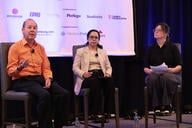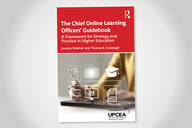You have /5 articles left.
Sign up for a free account or log in.
A recent analysis from the American Association of University Professors found that 73 percent of all instructional faculty in the U.S. were in non-tenure-track positions. The AAUP report concluded that contingent faculty occupy roles that are largely “insecure” and “unsupported,” with “little job security and few protections for academic freedom.”
There are many problems with this situation, and as shown by many recent articles, economic hardship is the most pressing among them.
Recently, we called out another issue we believe is worth discussing -- the relationship between faculty roles and learning innovation. We asked, if the large majority of faculty are in non-tenure-track positions, what role are they asked to play in the innovative strategies of their college or university?
Attend a digital learning professional conference, and you will hear little discussion on the growth of the contingent faculty workforce. Publications and websites designed to reach the digital learning community rarely address the issues facing contingent faculty.
Even less is said about part-time, adjunct and other non-tenure-track educators at convenings that focus on innovation and “disruption,” and the potential for for-profit partnerships to “revolutionize” the higher education ecosystem.
It’s important to ask how we can support growth, innovation and the future of higher education without acknowledging and supporting the faculty who carry out this mission.
One simple approach is to consider how any new digital learning initiative supports and fosters engagement with all faculty on any given campus.
Another would be to think about how digital initiatives might be adopted by faculty who may not have access to the same level of institutional resources as tenure-line faculty.
A third approach is to make sure that all digital initiatives bring together inclusive cohorts of faculty in conversation with one another. The campus community is strongest when it fully reflects the diversity of that community.
Any digital learning initiative that does not serve to support the needs of educators, in addition to students and institutions, will ultimately be ineffective. In an environment where three-quarters of all professors are non-tenure track, the probability that any digital learning efforts will impact contingent faculty is high.
This emphasis on the human beings who teach our students is nothing if not an extension of the relational model of education we think is fundamental to the success (past and future) of higher education. A relational model of education puts the relationship between educators and students at the center of learning. It emphasizes the transformation of the individual, not the exchange of information for tuition.
Teaching and learning methods that privilege content and assessment above coaching and mentoring will be of limited long-term impact. Authentic learning, in our worldview, occurs at the level of human interaction.
This is not to say that individuals can’t learn from anything beyond a professor. We spend our lives enmeshed in information. The digital age has reduced the cost and friction of information acquisition to near zero.
Education that is not relational, though, is freely available elsewhere. In order to stay in business, colleges and universities will need to provide both an educational experience and certification of individual potential that goes beyond what can be had digitally at little to no cost.
That value add will increasingly be the individual attention and expertise that a skilled educator brings to the instructional relationship. In an age of ubiquitous information, the educator becomes more rather than less important in determining the value of an education.
If this idea, that the value of the educator increases in proportion to the decline in the cost of acquiring information, is true, then it also stands to reason that any system that devalues educators (such as not providing support of non-tenure-line contracts through employment and promotion frameworks, inclusion in governance, and the extension of protections of academic freedom) will be counterproductive.
Colleges and universities may save money in the short term by ignoring the health and well-being of many of their faculty, but this strategy will catch up to the schools that employ this tactic through lower-quality educational offerings and the related diminishment of reputation and esteem.
The fastest method to ensure that public universities continue to lose public support (and funding) is to offer a suboptimal education. The same argument holds true for tuition-dependent public and private institutions. The key differentiator that colleges and universities can offer will ultimately center on the quality of the learning experience that they provide. An underinvestment in instruction by not supporting the professional growth of many of their faculty is one way to drive down the quality of education.
Increasingly, the strategies that colleges and universities follow to enhance their teaching and student learning will involve digital technologies. The only way that most institutions will survive and thrive in the coming years will be to embrace new types of students (working, adult, part-time) and to develop new programs and degrees (including alternative certificates).
Education will continue to transition from a full-time, time-bound and residential activity to one that is part-time, lifelong and online.
What can’t happen is that for this evolution of higher education to a digitally mediated industry to occur at the cost of educator security and autonomy. Faculty, both tenure track and non-tenure track, need to benefit from the shift to digital learning.
Our digital learning community should prioritize the development of an understanding of faculty labor dynamics to the same level in which we pursue expertise in learning science and new educational technologies.
At conferences and events where digital learning people gather, we should spend as much time discussing how we will support all faculty as we do talking about the impact of our projects and initiatives on our students and our schools.
Until and unless our digital learning community carves out a leadership role in supporting all faculty, we will persist in operating at the margins of higher education leadership.




